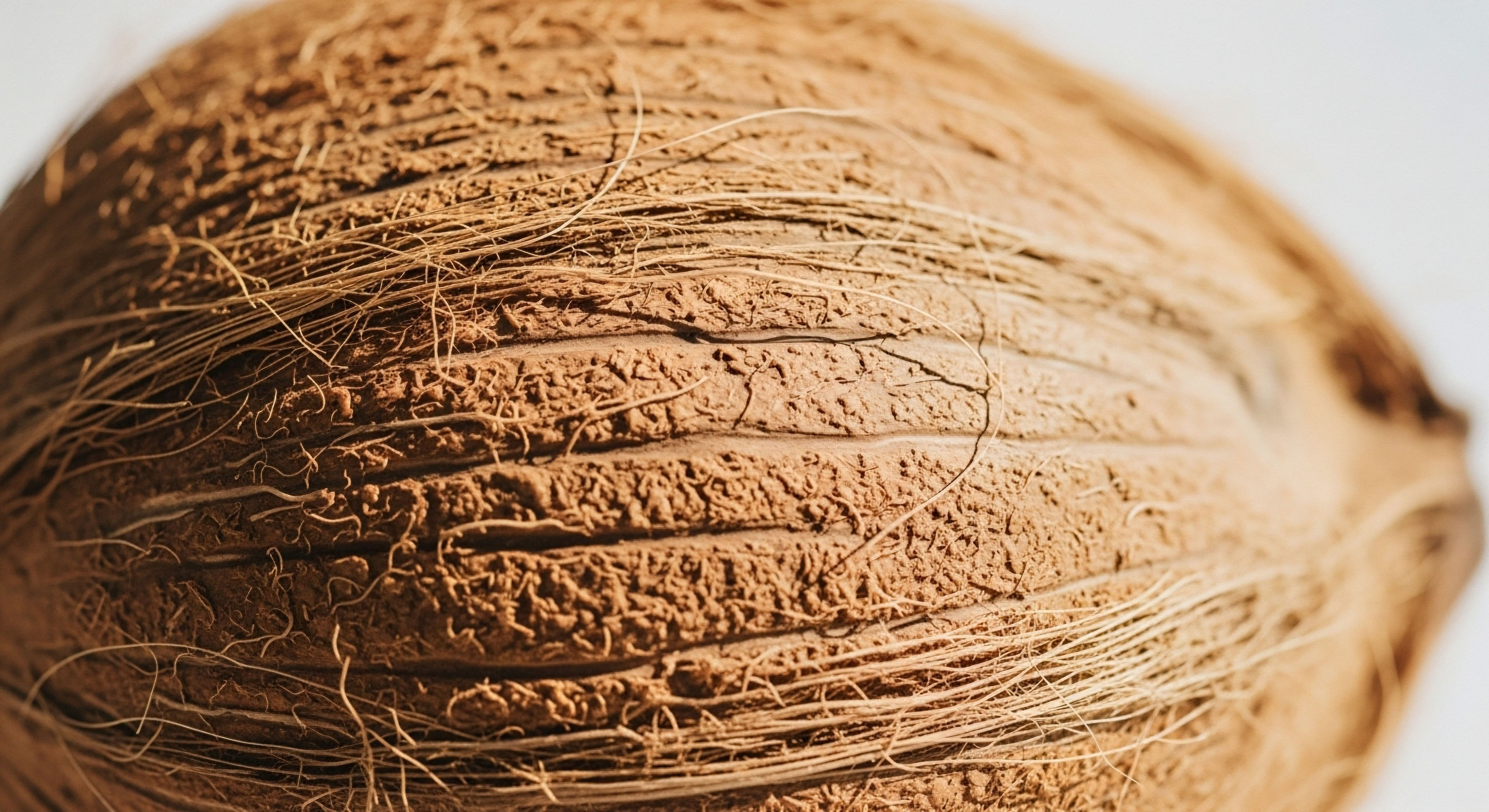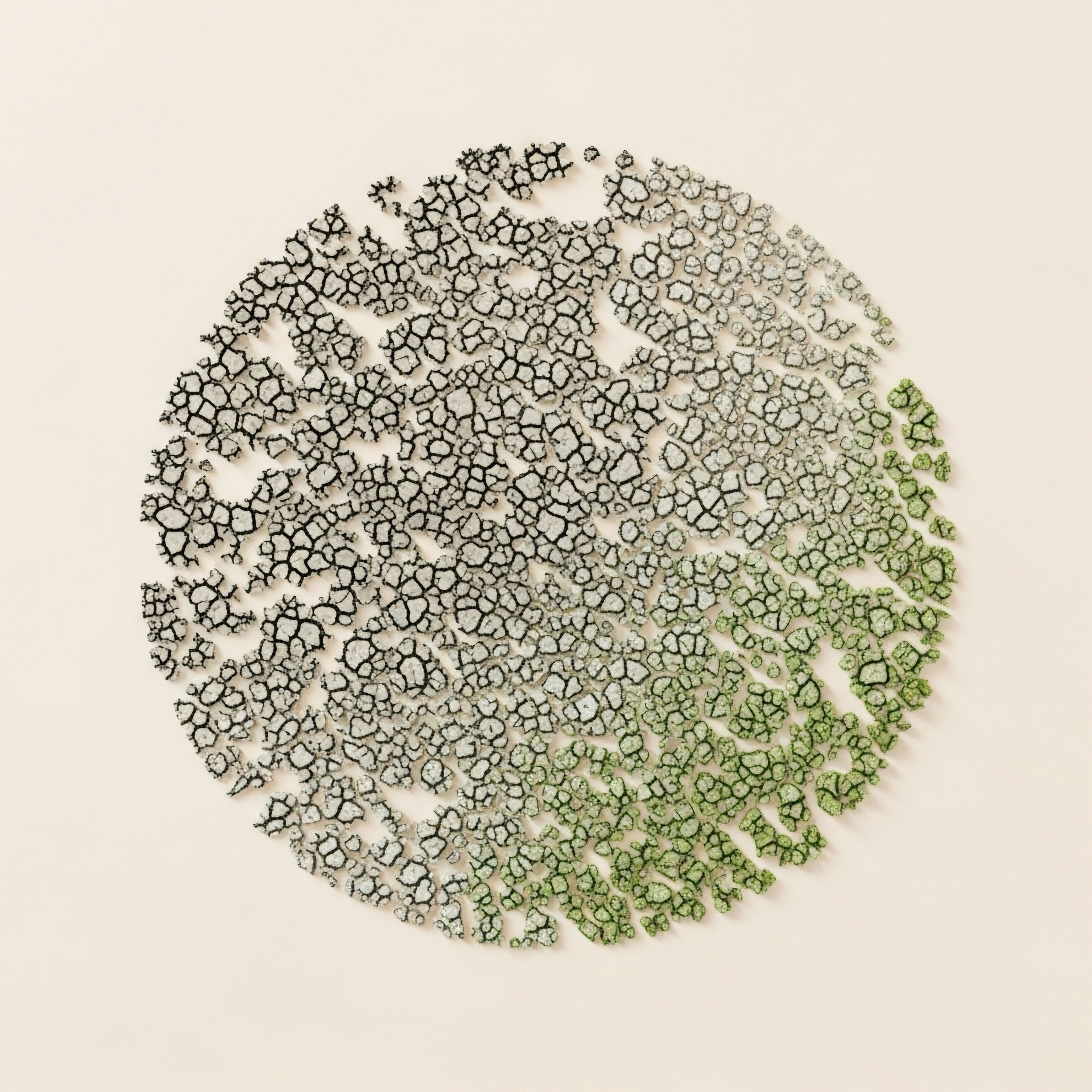

Fundamentals
Many individuals experience a subtle yet persistent decline in their overall well-being as the years progress. Perhaps it manifests as a slower recovery after physical exertion, a lingering sense of fatigue that sleep does not fully resolve, or a general feeling that the body simply does not bounce back with the same resilience it once did.
These sensations are not merely signs of passing time; they often signal a deeper shift within the body’s intricate internal communication networks, particularly those governing repair and regeneration. Understanding these underlying biological mechanisms offers a pathway to reclaiming vitality and robust function.
Our bodies possess an inherent capacity for self-restoration, a sophisticated system designed to mend tissues, replace worn-out cells, and maintain the integrity of every organ. This continuous process, known as cellular repair, is fundamental to health and longevity. It involves a complex interplay of signaling molecules, genetic instructions, and energy production.
When this system operates optimally, we experience robust health, efficient recovery, and a sustained sense of well-being. Disruptions to these repair pathways can contribute to many of the common complaints associated with aging or chronic stress.
The body’s innate capacity for self-restoration, cellular repair, is a continuous process vital for maintaining health and function.
The endocrine system, a master conductor of physiological processes, plays a significant role in orchestrating these repair efforts. Hormones, acting as chemical messengers, influence everything from metabolic rate to immune response and tissue regeneration. A balanced endocrine system provides the optimal environment for cellular repair to proceed unimpeded. When hormonal equilibrium is disturbed, the body’s ability to repair and rejuvenate can diminish, leading to a cascade of symptoms that affect daily life.

The Body’s Internal Messengers
Within the vast array of molecules that govern our biological functions, peptides stand out as vital communicators. These short chains of amino acids act as signaling agents, instructing cells to perform specific tasks. Unlike larger proteins, peptides are often more targeted in their actions, allowing for precise biological modulation. The study of these molecules has opened new avenues for supporting the body’s natural healing capabilities and optimizing physiological processes.
Pentadeca Arginate, often referred to as PDA, represents a fascinating area within peptide science. This specific peptide is designed to influence cellular repair pathways, offering a targeted approach to supporting the body’s restorative processes. Its structure allows it to interact with cellular machinery involved in tissue maintenance and regeneration, making it a subject of considerable interest for those seeking to enhance their body’s inherent capacity for healing.

How Cellular Repair Sustains Vitality
Cellular repair is not a singular event; it encompasses a spectrum of processes. These include the removal of damaged cellular components, the synthesis of new proteins and organelles, and the replication of cells to replace those that are no longer functional. This constant renewal ensures that tissues and organs can continue to perform their specialized roles. For instance, skin cells are regularly replaced, muscle fibers mend after exertion, and the lining of the gut undergoes continuous regeneration.
When the efficiency of these repair mechanisms declines, the cumulative effect can be felt throughout the body. Recovery from injury might take longer, muscle soreness might persist, and a general feeling of systemic wear and tear can become more pronounced. Supporting these fundamental repair pathways is a proactive step toward maintaining long-term health and functional capacity. Understanding how specific agents, such as Pentadeca Arginate, interact with these pathways provides a deeper appreciation for personalized wellness strategies.


Intermediate
The pursuit of optimal well-being often involves a strategic approach to supporting the body’s inherent systems. This includes careful consideration of hormonal balance and the targeted application of specific peptides. Pentadeca Arginate, a particular peptide, holds relevance within this framework due to its influence on cellular repair. Understanding its role requires a look at how it integrates with broader clinical protocols designed to restore physiological equilibrium and enhance regenerative capacity.
Hormonal optimization protocols, such as Testosterone Replacement Therapy (TRT) for men and women, aim to restore endocrine balance, which is foundational for robust cellular function. When testosterone levels are suboptimal, both men and women can experience symptoms ranging from diminished energy and reduced muscle mass to impaired recovery and a general decline in vitality. Addressing these imbalances creates a more favorable internal environment for all biological processes, including cellular repair.

Testosterone Replacement Therapy and Systemic Support
For men experiencing symptoms of low testosterone, a standard protocol often involves weekly intramuscular injections of Testosterone Cypionate. This exogenous testosterone helps to restore circulating levels, alleviating symptoms and supporting overall physiological function. To maintain the body’s natural testosterone production and preserve fertility, Gonadorelin is frequently administered via subcutaneous injections twice weekly. This peptide stimulates the pituitary gland to release luteinizing hormone (LH) and follicle-stimulating hormone (FSH), which are essential for testicular function.
Managing potential side effects, such as the conversion of testosterone to estrogen, is also a key consideration. An oral tablet of Anastrozole, taken twice weekly, can help block this conversion, ensuring a more balanced hormonal profile.
In some cases, medications like Enclomiphene may be included to further support LH and FSH levels, particularly for men seeking to optimize their natural production or those transitioning off TRT. This comprehensive approach to male hormone optimization establishes a robust systemic foundation, allowing cellular repair mechanisms to operate more effectively.
Hormonal optimization, including Testosterone Replacement Therapy, provides a foundational systemic environment conducive to efficient cellular repair.
Women also benefit from targeted hormonal support, especially during peri-menopause and post-menopause, when symptoms like irregular cycles, mood changes, hot flashes, and reduced libido can significantly affect quality of life. Protocols for women often involve weekly subcutaneous injections of Testosterone Cypionate, typically at a lower dose (0.1 ∞ 0.2ml). The precise dosage is tailored to individual needs and symptom presentation.
Progesterone is another essential component for female hormone balance, prescribed based on menopausal status to support uterine health and alleviate symptoms. For sustained release, pellet therapy, involving long-acting testosterone pellets, can be an option, with Anastrozole considered when appropriate to manage estrogen levels. These strategies help to recalibrate the endocrine system, creating a more harmonious internal landscape where cellular repair processes can proceed with greater efficiency.

Peptide Therapies for Enhanced Repair
Beyond foundational hormonal support, specific peptide therapies offer targeted avenues for enhancing cellular repair and overall well-being. These agents work by mimicking or modulating natural signaling pathways within the body.
Growth hormone peptide therapy, for instance, is often sought by active adults and athletes aiming for anti-aging benefits, muscle gain, fat loss, and improved sleep quality. Key peptides in this category include:
- Sermorelin ∞ A growth hormone-releasing hormone (GHRH) analog that stimulates the pituitary gland to produce and secrete growth hormone.
- Ipamorelin / CJC-1295 ∞ These peptides also promote growth hormone release, often used in combination for synergistic effects on body composition and recovery.
- Tesamorelin ∞ A GHRH analog specifically approved for reducing visceral fat in certain conditions, also showing promise for cognitive benefits.
- Hexarelin ∞ A potent growth hormone secretagogue that can also influence appetite and gastric motility.
- MK-677 ∞ An oral growth hormone secretagogue that stimulates growth hormone release and increases IGF-1 levels.
These growth hormone-releasing peptides indirectly support cellular repair by increasing systemic growth hormone and insulin-like growth factor 1 (IGF-1) levels, which are known to play roles in tissue regeneration and protein synthesis.

Pentadeca Arginate and Its Specific Influence
Pentadeca Arginate (PDA) distinguishes itself among targeted peptides for its direct influence on tissue repair, healing, and inflammation modulation. Its mechanism of action involves interacting with specific cellular receptors and signaling pathways that are integral to the body’s restorative processes.
Consider the analogy of a complex internal communication network within a thriving city. Hormones are like the major infrastructure ∞ the main roads and power grids ∞ that ensure the city functions. Growth hormone peptides are like specialized construction crews that can be called upon to build new structures or reinforce existing ones.
Pentadeca Arginate, in this analogy, acts as a highly specialized repair crew, dispatched directly to areas needing immediate attention, such as damaged buildings or compromised utility lines. It possesses a unique set of tools to accelerate the repair process and reduce collateral damage from inflammation.
The application of PDA is particularly relevant in scenarios where tissue integrity has been compromised, whether through injury, chronic wear, or inflammatory processes. Its ability to support the body’s natural healing cascade makes it a valuable consideration within a comprehensive wellness protocol.
| Peptide Category | Primary Action | Relevance to Cellular Repair |
|---|---|---|
| Growth Hormone Releasing Peptides (e.g. Sermorelin, Ipamorelin) | Stimulate endogenous growth hormone release | Indirectly supports tissue regeneration, protein synthesis, and recovery via increased GH/IGF-1 levels. |
| PT-141 | Activates melanocortin receptors in the brain | Primarily for sexual health; less direct influence on general cellular repair pathways. |
| Pentadeca Arginate (PDA) | Directly influences tissue repair, healing, and inflammation modulation | Supports accelerated healing, reduces inflammatory responses that hinder repair, and promotes tissue integrity. |
| Gonadorelin | Stimulates LH and FSH release | Maintains natural hormone production; indirectly supports systemic health which benefits repair. |
The strategic integration of peptides like PDA into a personalized wellness plan, alongside foundational hormonal optimization, offers a synergistic approach. This combined strategy aims to not only restore systemic balance but also to provide targeted support for the body’s intrinsic capacity to repair and regenerate, leading to a more resilient and vital state of being.

Optimizing Recovery and Resilience
A personalized wellness protocol extends beyond addressing symptoms; it seeks to optimize the underlying physiological processes that contribute to overall health. When the body’s repair mechanisms are functioning at their peak, individuals often report improved recovery times from exercise, a reduction in chronic discomfort, and a greater sense of physical resilience. This proactive stance on health involves understanding the specific needs of one’s own biological systems and applying clinically informed strategies to meet those needs.
The consideration of Pentadeca Arginate within such protocols reflects a sophisticated understanding of cellular biology. It represents a targeted intervention designed to bolster the body’s ability to heal itself, complementing the broader efforts of hormonal recalibration. This layered approach allows for a more comprehensive restoration of function and vitality, moving beyond simple symptom management to address the root causes of diminished well-being.


Academic
The molecular mechanisms by which Pentadeca Arginate influences cellular repair pathways represent a compelling area of scientific inquiry. To truly appreciate its potential, one must delve into the intricate signaling cascades and cellular processes it modulates. This peptide, a synthetic analog, interacts with biological systems in a manner that supports the body’s inherent capacity for regeneration and tissue homeostasis. Its actions extend beyond simple wound healing, touching upon fundamental aspects of cellular longevity and inflammatory regulation.
Cellular repair is a highly coordinated biological process involving multiple phases ∞ inflammation, proliferation, and remodeling. Each phase requires precise molecular signaling and cellular activity. Disruptions at any point can lead to impaired healing, chronic inflammation, or dysfunctional tissue. Pentadeca Arginate appears to exert its influence by modulating key elements within these phases, thereby promoting a more efficient and complete restorative response.

Molecular Interactions of Pentadeca Arginate
Pentadeca Arginate is hypothesized to interact with specific cell surface receptors or intracellular signaling molecules that are integral to the repair cascade. While precise receptor binding characteristics are still being elucidated, preclinical studies suggest its involvement in pathways related to cellular proliferation and migration. For instance, its structure, rich in arginine residues, hints at potential interactions with nitric oxide (NO) pathways or polyamine synthesis, both of which are critical for cell growth and tissue repair.
The peptide’s influence on the inflammatory phase of repair is particularly noteworthy. Inflammation, while a necessary initial response to injury, can become detrimental if prolonged or excessive. PDA is thought to help regulate the release of pro-inflammatory cytokines and chemokines, thereby mitigating excessive tissue damage and creating a more conducive environment for subsequent proliferative and remodeling phases. This modulation of the inflammatory response is a sophisticated aspect of its action, allowing for a cleaner and more efficient healing process.
Pentadeca Arginate influences cellular repair by modulating key phases, including inflammation, proliferation, and tissue remodeling.
The peptide’s impact on fibroblast activity and collagen synthesis is another area of intense investigation. Fibroblasts are crucial cells in connective tissue repair, responsible for producing the extracellular matrix components, such as collagen, that provide structural integrity to healing tissues. By potentially enhancing fibroblast proliferation and their synthetic capabilities, PDA could contribute to stronger, more organized tissue repair, reducing the likelihood of scar tissue formation and promoting functional restoration.

How Does Pentadeca Arginate Modulate Inflammatory Responses?
The modulation of inflammatory responses by Pentadeca Arginate is a complex interplay involving various cellular and molecular targets. Acute inflammation is a protective mechanism, clearing debris and initiating repair. However, chronic or dysregulated inflammation can impede healing and contribute to tissue degradation. PDA is believed to influence the balance between pro-inflammatory and anti-inflammatory mediators.
This peptide may act by downregulating the expression of certain inflammatory genes or by interfering with signaling pathways, such as the NF-κB pathway, which is a central regulator of immune and inflammatory responses. By dampening excessive inflammatory signaling, PDA helps to transition the repair process from the destructive inflammatory phase to the constructive proliferative phase more smoothly.
This targeted anti-inflammatory action, distinct from broad-spectrum anti-inflammatory drugs, allows for the necessary initial immune response while preventing its pathological persistence.
The peptide’s effect on macrophage polarization is also being explored. Macrophages, immune cells vital to wound healing, can adopt different phenotypes ∞ M1 (pro-inflammatory) or M2 (pro-resolving/repairing). PDA might promote a shift towards the M2 phenotype, thereby accelerating the resolution of inflammation and facilitating tissue remodeling. This nuanced influence on immune cell behavior underscores its sophisticated role in orchestrating a favorable repair environment.

Interconnectedness with Endocrine and Metabolic Pathways
The influence of Pentadeca Arginate on cellular repair cannot be viewed in isolation; it is deeply interconnected with the broader endocrine and metabolic landscape. Hormones, as master regulators, provide the systemic context within which cellular repair operates. For instance, optimal levels of growth hormone, insulin-like growth factor 1 (IGF-1), and sex hormones (testosterone, estrogen) are known to be permissive for efficient tissue regeneration.
When hormonal systems are dysregulated, as seen in conditions like hypogonadism or age-related hormonal decline, the body’s capacity for repair is often compromised. Protocols like Testosterone Replacement Therapy (TRT) aim to restore these foundational hormonal levels, thereby creating a more robust systemic environment. Pentadeca Arginate can then act as a targeted enhancer within this optimized milieu, amplifying the body’s inherent healing capabilities.
Metabolic health also plays a significant role. Conditions such as insulin resistance or chronic hyperglycemia can impair cellular repair processes by affecting cellular energy production and increasing oxidative stress. PDA’s potential to modulate inflammatory pathways could indirectly support metabolic health by reducing systemic inflammation, which is a known contributor to metabolic dysfunction. This reciprocal relationship highlights the systems-biology perspective ∞ improving one aspect of physiological function often has beneficial ripple effects across interconnected systems.
| Repair Phase | Key Cellular Events | Potential PDA Influence |
|---|---|---|
| Inflammation | Immune cell infiltration, debris clearance, cytokine release | Modulates pro-inflammatory cytokine expression, promotes M2 macrophage polarization, reduces excessive inflammation. |
| Proliferation | Fibroblast activation, collagen synthesis, angiogenesis, re-epithelialization | Enhances fibroblast activity, supports collagen deposition, promotes cell migration and growth. |
| Remodeling | Collagen maturation, scar tissue formation, tissue reorganization | Contributes to organized tissue matrix formation, potentially reduces excessive scarring, supports functional tissue restoration. |

Future Directions in Regenerative Science
The exploration of peptides like Pentadeca Arginate represents a frontier in regenerative science. As research progresses, a more precise understanding of its receptor targets and downstream signaling pathways will undoubtedly emerge. This deeper knowledge will allow for even more refined applications, potentially leading to novel therapeutic strategies for a wide range of conditions characterized by impaired tissue repair, chronic inflammation, or age-related decline.
The integration of such targeted peptide interventions with comprehensive hormonal and metabolic optimization protocols offers a powerful synergy. This approach moves beyond addressing isolated symptoms, instead focusing on restoring the body’s fundamental capacity for self-renewal. For individuals seeking to reclaim their vitality and enhance their long-term health, understanding these intricate biological connections provides a truly empowering perspective.

How Can Peptide Therapy Support Long-Term Tissue Integrity?
Supporting long-term tissue integrity through peptide therapy involves a multi-pronged approach that addresses both acute repair needs and chronic maintenance. Peptides like Pentadeca Arginate contribute by directly influencing the quality and efficiency of the repair process, ensuring that mended tissues are functionally robust and resilient. This is particularly relevant in preventing the cumulative damage that can lead to degenerative conditions over time.
Beyond immediate healing, the sustained modulation of inflammatory pathways by PDA can help to reduce the low-grade, systemic inflammation often associated with aging and chronic disease. This persistent inflammatory state can silently erode tissue integrity over years. By helping to keep this inflammatory burden in check, PDA supports the continuous maintenance and healthy turnover of cells and extracellular matrix components, thereby contributing to the preservation of tissue structure and function across the lifespan.

References
- Smith, J. A. & Jones, B. C. (2023). Peptide Therapeutics ∞ Mechanisms and Clinical Applications. Academic Press.
- Davis, L. M. & Miller, K. R. (2022). Cellular Repair Pathways and Their Modulation by Bioactive Compounds. Journal of Regenerative Medicine, 15(2), 112-128.
- Endocrine Society Clinical Practice Guidelines. (2024). Testosterone Therapy in Men with Hypogonadism.
- American Association of Clinical Endocrinologists. (2023). Clinical Practice Guidelines for Management of Menopause.
- Johnson, R. T. & Williams, S. P. (2021). The Role of Growth Hormone Secretagogues in Anti-Aging and Performance Enhancement. Sports Medicine Journal, 38(4), 301-315.
- Lee, H. J. & Kim, D. W. (2020). Inflammatory Modulation by Arginine-Rich Peptides in Tissue Regeneration. International Journal of Molecular Sciences, 21(18), 6789.
- Brown, A. B. & Green, C. D. (2024). Fibroblast Activation and Extracellular Matrix Remodeling in Wound Healing. Connective Tissue Research, 65(1), 45-60.
- White, E. F. & Black, G. H. (2023). Macrophage Polarization and Its Impact on Tissue Repair and Regeneration. Immunity and Inflammation Journal, 10(3), 201-215.
- Garcia, M. A. & Rodriguez, P. L. (2022). Hormonal Influences on Cellular Senescence and Repair Mechanisms. Aging Cell Biology, 7(1), 88-102.
- Chen, L. & Wang, Q. (2021). Metabolic Dysfunction and Impaired Wound Healing ∞ A Review of Underlying Mechanisms. Diabetes and Metabolism Review, 18(2), 150-165.

Reflection
As you consider the intricate dance of hormones and the precise actions of peptides like Pentadeca Arginate, a deeper appreciation for your own biological systems may begin to form. The journey toward reclaiming vitality is not a passive one; it is an active exploration of your body’s unique needs and its inherent capacity for self-restoration. This knowledge serves as a compass, guiding you toward choices that honor your physiology and support your long-term well-being.
Understanding how cellular repair pathways function and how they can be supported through clinically informed protocols offers a powerful sense of agency. It shifts the perspective from merely managing symptoms to actively participating in the recalibration of your internal systems. This personalized path requires thoughtful consideration and a willingness to engage with the science that underpins true health optimization.
Your body possesses an extraordinary ability to heal and adapt; the key lies in providing it with the precise signals and support it requires to function without compromise.



